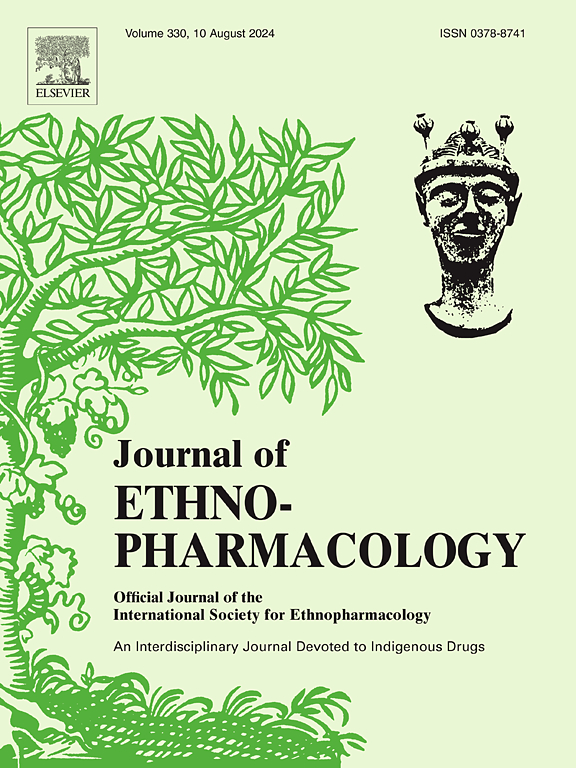Calycosin limits hepatic fibrogenesis via KLF15 dependent repression of P2X7R in thioacetamide-induced hepatic fibrosis
IF 4.8
2区 医学
Q1 CHEMISTRY, MEDICINAL
引用次数: 0
Abstract
Ethnopharmacological relevance
Astragalus membranaceus (Fisch.) Bunge is a traditional Chinese medicinal herb that has been documented for its hepatoprotective properties and therapeutic potential. Calycosin, derived from Astragalus membranaceus (Fisch.) Bunge is a natural flavonoid widely used in ameliorating chronic liver diseases.
Aim of the study
The current study investigates hepatoprotective effects as well as the underlying mechanism of Calycosin on hepatic fibrosis.
Materials and methods
Hepatic fibrosis was induced in mice (n = 6) by intraperitoneal injection of thioacetamide (TAA). Subsequently, we deduced the hepatic fibrosis signaling network using RNA sequencing. LX-2 and mouse primary hepatocytes were transfected with the siRNA-KLF15; mouse bone marrow-derived macrophages (BMDMs) were also treated with LPS/ATP and Calycosin to produce conditioned medium. Dual luciferase assay characterized KLF15-P2X7r promoter interaction.
Results
RNA sequencing showed that the KLF15/NOD-like receptor pathway played a significant role in the Calycosin-mediated hepatoprotection in TAA-induced mouse models. Calycosin treatment resulted in a 33 % reduction in ALT and a 35 % decrease in AST levels. In TAA-induced mouse models of hepatic fibrosis, Calycosin greatly diminished the formation of neutrophil extracellular traps. Calycosin treatment induced KLF15 upregulation and a 3-fold reduction in P2X7R protein expression. In the hepatocyte and LX-2, KLF15 deletion cancels the inhibitory effect of Calycosin on the P2X7r. It is shown that KLF15 directly binds to the P2X7r promoter. Furthermore, Calycosin blocked pyroptosis in BMDMs, especially via Calycosin interaction with HSCs-macrophage crosstalk.
Conclusions
This study implies that Calycosin alleviates hepatic fibrosis in the fibroinflammatory lesion through modulating the KLF15-P2X7r/NLRP3 signaling pathway.

在硫代乙酰胺诱导的肝纤维化中,毛蕊异黄酮通过KLF15依赖性抑制P2X7R抑制肝纤维化。
民族药理学相关性:黄芪(黄芪属)邦吉是一种传统的中草药,具有保护肝脏的特性和治疗潜力。毛蕊花素,源自黄芪(黄芪属)邦吉是一种天然类黄酮,广泛用于改善慢性肝病。研究目的:本研究旨在探讨毛蕊异黄酮对肝纤维化的保护作用及其机制。材料与方法:腹腔注射硫乙酰胺(TAA)诱导小鼠肝纤维化(n=6)。随后,我们使用RNA测序推断了肝纤维化信号网络。用siRNA-KLF15转染LX-2和小鼠原代肝细胞;小鼠骨髓源性巨噬细胞(BMDMs)也用LPS/ATP和花萼异黄酮处理以产生条件培养基。双荧光素酶测定表征KLF15-P2X7r启动子相互作用。结果:RNA测序结果显示,KLF15/ nod样受体通路在花萼异黄酮诱导的taa小鼠模型中发挥了显著的肝保护作用。毛蕊异黄酮治疗导致谷丙转氨酶下降33%,谷丙转氨酶水平下降35%。在taa诱导的肝纤维化小鼠模型中,毛蕊异黄酮大大减少了中性粒细胞胞外陷阱的形成。毛蕊异黄酮处理诱导KLF15上调,P2X7R蛋白表达降低3倍。在肝细胞和LX-2中,KLF15的缺失取消了毛蕊异黄酮对P2X7r的抑制作用。结果表明KLF15直接结合P2X7r启动子。此外,毛蕊异黄酮通过与hscs -巨噬细胞串扰的相互作用,阻断了BMDMs的焦亡。结论:本研究提示毛蕊异黄酮通过调节KLF15-P2X7r/NLRP3信号通路减轻纤维炎性病变的肝纤维化。
本文章由计算机程序翻译,如有差异,请以英文原文为准。
求助全文
约1分钟内获得全文
求助全文
来源期刊

Journal of ethnopharmacology
医学-全科医学与补充医学
CiteScore
10.30
自引率
5.60%
发文量
967
审稿时长
77 days
期刊介绍:
The Journal of Ethnopharmacology is dedicated to the exchange of information and understandings about people''s use of plants, fungi, animals, microorganisms and minerals and their biological and pharmacological effects based on the principles established through international conventions. Early people confronted with illness and disease, discovered a wealth of useful therapeutic agents in the plant and animal kingdoms. The empirical knowledge of these medicinal substances and their toxic potential was passed on by oral tradition and sometimes recorded in herbals and other texts on materia medica. Many valuable drugs of today (e.g., atropine, ephedrine, tubocurarine, digoxin, reserpine) came into use through the study of indigenous remedies. Chemists continue to use plant-derived drugs (e.g., morphine, taxol, physostigmine, quinidine, emetine) as prototypes in their attempts to develop more effective and less toxic medicinals.
 求助内容:
求助内容: 应助结果提醒方式:
应助结果提醒方式:


